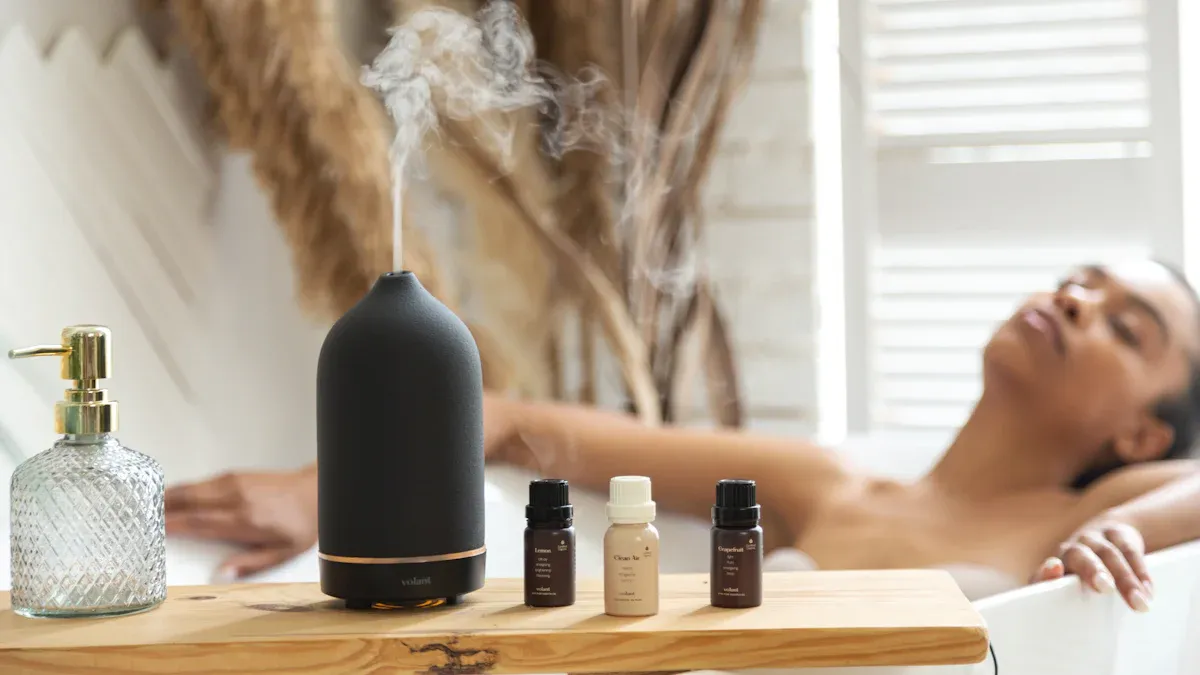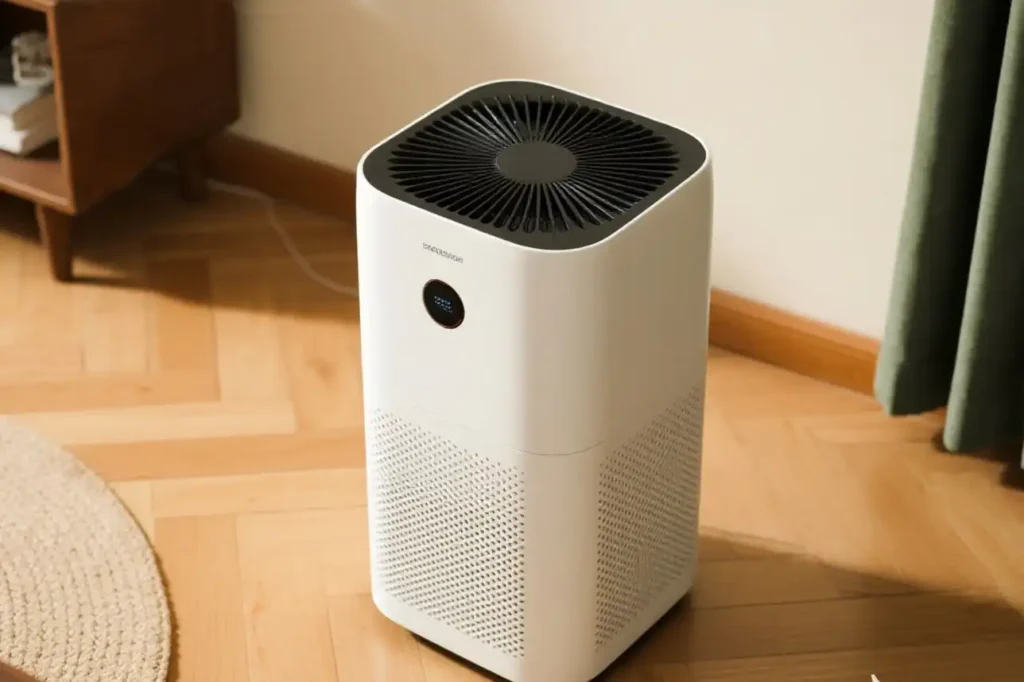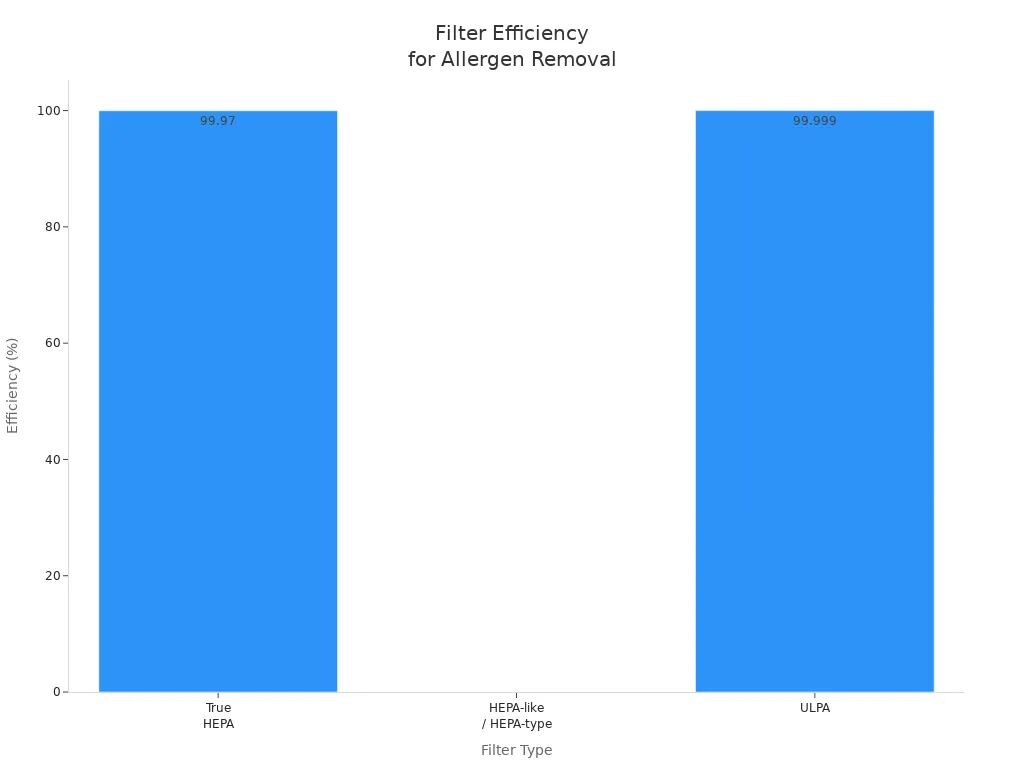
Do you have a stuffy nose that will not go away? You are not the only one. Studies say up to 60% of people with allergic rhinitis have a blocked nose every day. Many people feel better when they use an air purifier at home. Clinical tests show that HEPA-filter air purifiers can help people use less allergy medicine. They also lower dust and pollen inside the house. In one survey, 55% of people said their noses were less stuffy after using an air purifier.
| Symptom | Percentage Decrease Reported |
|---|---|
| Runny or stuffy nose (including nasal congestion) | 55% |
| Sneezing | 36% |
| Itchy nose or eyes | 63% |
| Red or watery eyes | 64% |
| Participants reporting overall allergy symptom improvement | 80% |
These results show that cleaner air inside your home can help you breathe better and feel good.
Key Takeaways
- Air purifiers with True HEPA filters catch tiny things like dust, pollen, and pet dander. This helps lower stuffy nose and allergy problems.
- Put the air purifier in rooms you use the most, like bedrooms or living rooms. This makes it work better to clean the air.
- Change the filters often to keep the air purifier working well. This gives you cleaner air and makes it easier to breathe.
- Use an air purifier, clean your home, and control humidity for the best results. This helps your sinuses feel clearer and lowers congestion.
- Many people feel less stuffy and sleep better after using an air purifier every day for a week.
Air Purifier Benefits

Allergen Removal
Most people spend a lot of time inside. Dust, pollen, pet dander, and mold can build up in the air indoors. These small things can make your nose feel itchy or blocked. An air purifier with a HEPA filter can help. It traps these allergens before you breathe them in. HEPA filters catch almost all tiny particles, even ones as small as 0.3 microns. This means the air you breathe is cleaner. You may have fewer allergy problems.
Tip: Put your air purifier in the room you use most. Bedrooms or living rooms are good choices for best results.
Many studies show air purifiers lower allergens in homes. One study lasted a year. People with asthma used HEPA air cleaners. They had fewer asthma attacks and less pet allergen in the air. Another study found HEPA air cleaners lowered cat allergens in the air. But they did not remove allergens on surfaces. Kids with pet allergies had fewer allergy problems at night when using an air purifier.
| Study / Source | Type of Evidence | Key Findings |
|---|---|---|
| Francis et al. | Randomized controlled trial | HEPA air cleaners improved asthma outcomes and reduced allergen levels. |
| Gore et al. | Observational study | HEPA air cleaners reduced airborne cat allergen while the cat was present. |
| Batterman et al. | 2-month study | HEPA air cleaners reduced particulate matter by 30-70%. |
| Bernstein et al. | Intervention study | HEPA filtration and dehumidification reduced airborne mold. |
| Sulser et al. | Clinical study | Children using HEPA air cleaners had fewer allergy symptoms at night. |
You might sneeze less and have less stuffy nose after using an air purifier. Your eyes may also itch less. In one study, people said their allergy symptoms dropped by 30% after using a HEPA air purifier. But remember, air purifiers work best if you also clean your home often. Keep windows closed when pollen is high outside.
Reducing Irritants
Air inside your house has more than just allergens. It can have smoke, cleaning chemicals, and tiny particles called particulate matter. These things can make your nose feel blocked and your sinuses hurt. An air purifier helps by taking out these bad particles and gases.
- HEPA filters catch almost all tiny particles, like pollen, dust, and pet dander.
- Some air purifiers can also break down gases and chemicals. They help remove bad smells and harmful things from the air.
- By lowering dust and other irritants, air purifiers help stop sneezing and stuffy nose.
- Cleaner air can help you sleep better by making your nose less stuffy at night.
A big study in South Korea showed people with dust mite allergies needed less allergy medicine when using air purifiers. Their homes had less indoor particulate matter, which is linked to stuffy nose. Lab tests show air purifiers remove almost all ultrafine particles. Some even kill germs caught in the filter.
Note: Air purifiers cannot get rid of every cause of stuffy nose. They do not clean outdoor air. They cannot remove allergens stuck on furniture or carpets. Use them with other steps like cleaning and keeping your home dry.
You may feel less stuffy within a week of using an air purifier. Some people sleep better and need less allergy medicine after a month. Still, doctors say air purifiers are just one way to help a chronic stuffy nose. They work best if you also keep your home clean and stay away from things that trigger your symptoms.
How It Works
Filtration Process
An air purifier takes air from your room and moves it through different filters. Each filter catches certain things that can make your nose feel blocked.
- HEPA filters catch 99.97% of tiny particles, even ones as small as 0.3 microns. These include dust mites, pollen, pet dander, and mold spores. You breathe in fewer allergens, so your nose stays clearer.
- Activated carbon filters soak up gases, smells, and chemicals. This step gets rid of smoke and cleaning fumes that can make your nose feel worse.
- Some air purifiers use UV-C light to kill bacteria and mold. This step helps lower the number of germs in your air.
- Ionization technology gives allergens a charge, so they stick to the filter better.
Tip: Change your filters often. Clean filters work best and keep your air fresh.
Some newer models use PECO technology. These filters trap allergens and also break down allergen proteins. This means there are fewer allergy triggers in your home. Studies show PECO filters can lower allergy markers more than regular HEPA filters.
Impact on Sinuses
Cleaner air means your nose and sinuses have fewer things to bother them. When you cut down on dust, pollen, and pet dander, you help stop sinus congestion and swelling. This makes it easier to breathe and sleep.
- Bad indoor air can cause sinus congestion, infections, and swelling.
- Air purifiers with HEPA and UV-C filters take out allergens and germs, which helps your sinuses feel better.
- By catching particles, you stop mucus from building up and help prevent sinus headaches.
- Using an air purifier can lower your chance of allergy attacks by removing triggers before you breathe them in.
Keeping your home clean, controlling humidity, and using an air purifier together is the best way to help your sinuses stay healthy.
You might notice less stuffiness and fewer sinus problems after a few weeks of cleaner air. Remember, air purifiers work best when you also vacuum, let in fresh air, and keep humidity between 30% and 50%.
Evidence and Results
Clinical Studies
Doctors and scientists wanted to know if air cleaning devices help with nose problems. They did tests to see if these devices work for people with stuffy or runny noses. In one big test, some people used a real device. Others used a fake one. The researchers checked how often people had a runny or blocked nose each day.
| Symptom Measure | Active Device Mean | Placebo Mean | Absolute Difference | Statistical Significance (p-value) | Relative Reduction (%) |
|---|---|---|---|---|---|
| Runny Nose (daily score) | 9.10 | 10.29 | 1.19 | 0.174 (not significant) | 12% |
| Runny Nose (maximum score) | 1.86 | 1.90 | 0.05 | 0.706 (not significant) | 3% |
| Blocked Nose (daily) | 5.95 | 6.38 | 0.43 | 0.702 (not significant) | 7% |
| Blocked Nose (maximum) | 1.43 | 1.43 | 0.00 | 0.928 (not significant) | N/A |
The table shows people with the real device had fewer nose problems than those with the fake one. The changes were small. Not all results were important in science. But some people still felt better and had fewer symptoms.
Another test used nasal filters and found a bigger drop in runny nose problems. In this test, people had a 53% drop in runny nose scores. Sneezing and watery eyes got better too. The results showed that using a filter or air cleaning device can help you feel less stuffy and make your life better.
When you use an air purifier, you might sneeze less and have less runny nose. You may also sleep better. Cleaner air can help you feel more comfortable at home.
User Experiences
Many people talk about using air purifiers for a stuffy nose. You might find your own story is like theirs. Some people say they breathe easier after a few days. Others notice fewer allergy attacks and do not need as much medicine.
- You might wake up with a clearer nose.
- You could sneeze less during the day.
- Some people say their headaches go away when the air is cleaner.
One parent said their child slept better and missed less school after using an air purifier in the bedroom. Another person said their nose felt less blocked, especially during allergy season. These stories show that real people often feel better when they use air cleaning devices at home.
Try using an air purifier in your bedroom or living room. You might see your nose and sinuses feel better after a few weeks.
Choosing an Air Purifier

HEPA Filters
If you want to help your stuffy nose, look at the filter first. True HEPA filters are the best for catching things that block your nose. They trap almost all tiny particles, even ones as small as 0.3 microns. This includes pollen, dust mites, pet dander, and mold spores. HEPA H13-certified filters can catch even smaller particles, down to 0.01 microns. This makes them very good for people with allergies.
| Filter Type | Particle Size Captured | Efficiency (%) | Typical Use Case |
|---|---|---|---|
| True HEPA | ≥ 0.3 microns | ≥ 99.97% | Residential, commercial, medical |
| HEPA-like / HEPA-type | ≥ 2.5 microns | Lower than true HEPA | Less critical environments, offices |
| ULPA | ≥ 0.12 microns | ≥ 99.999% | Specialized cleanrooms, medical labs |
True HEPA filters work better than HEPA-like filters. HEPA-like filters only catch bigger particles and are not as strong. ULPA filters are even stronger but are not needed in most homes. Remember, HEPA filters do not take out gases or bad smells. For best results, pick a purifier that has both HEPA and activated carbon filters.

Tip: Change your HEPA filter once a year or when the maker says. This keeps your air purifier working well.
Other Features
There are many extra features that can help your nose and make the purifier easier to use. Look for these options:
- Multi-layer filters catch dust, pollen, and tiny particles.
- Activated carbon filters take out bad smells and gases like VOCs.
- UV-C light can kill germs that make your nose feel worse.
- Air quality sensors show you when the air needs cleaning.
- Quiet machines let you run them all night without noise.
- 360° air intake helps clean the air faster and better.
- Smart controls, like apps or voice, make it easy to use.
- Putting the purifier in the right spot helps it work best.
Cost is important, too. Good filters last longer and need fewer changes, so you save money. Some brands work well and do not cost too much. You do not always need the most expensive one to get good results. Many people say they sleep better, have less stuffy nose, and breathe easier after using a good air purifier.
Usage Tips
Placement
Where you put your device matters for the best results. Follow these steps to help your nose feel clearer:
- Place the device near your breathing zone, such as on a nightstand close to your bed.
- Keep it off the floor and away from corners or hidden spots. This helps air move freely.
- Set the device about three feet above the ground to catch both high and low air.
- Make sure nothing blocks the airflow. Leave about three feet of open space around it.
- Run the device all day and night, especially while you sleep.
In rooms with good air movement, placement matters less. In rooms with poor air flow, careful placement helps the device work better. Choose a model that matches your room size. Check the Clean Air Delivery Rate (CADR) to make sure it fits your space.
Maintenance
Keep your device working well by changing filters on time. Dirty filters trap fewer allergens and can even release them back into the air. Most high-quality filters need changing once a year. Some lower-quality filters need changing three or four times a year. Always follow the maker’s instructions.
Tip: Mark your calendar for filter changes. Clean filters help you breathe easier and keep your nose less stuffy.
If you skip filter changes, the device will not work as well. Pollutants can build up and make your symptoms worse.
Extra Steps
You can do more to help your nose feel better:
- Use saline rinses to clear mucus.
- Wash bedding weekly in hot water.
- Remove carpets and use hard floors.
- Control humidity between 30% and 50%.
- Avoid smoke, strong scents, and harsh chemicals.
- Shower after being outside to remove pollen.
- Work with your doctor to manage allergies.
These steps, along with your device, help keep your nose clear and your air clean.
You can take control of your nasal health by making your indoor air cleaner. Studies show you may see a 55% drop in stuffy nose and a 27% reduction in allergy symptoms. To get the best results:
- Choose a device with a True HEPA filter.
- Match the device to your room size.
- Combine it with regular cleaning and good habits.
Remember, these devices do not dry out your sinuses. Start today and breathe easier at home.
FAQ
Can an air purifier help with stuffy nose from a cold?
You may feel some relief, but air purifiers work best for allergies and dust. They do not treat viruses. You should rest, drink fluids, and follow your doctor’s advice for colds.
How long does it take to notice results from an air purifier?
Most people notice less stuffiness within a week. You may see bigger changes after a month of regular use. Keep your air purifier running and change filters as needed.
Do air purifiers dry out the air or sinuses?
No, air purifiers do not remove moisture from the air. Your nose and throat will not get dry from using one. If you need more moisture, use a humidifier.
Where should I place my air purifier for best results?
Put your air purifier near your bed or where you spend the most time. Keep it away from walls and corners. Make sure nothing blocks the airflow.
Can I use an air purifier if I have pets?
Yes, you can use an air purifier with pets. It helps remove pet dander and hair from the air. You may notice less sneezing and fewer allergy symptoms.
See also
Top Ways Air Purifiers Improve Your Home Environment
What Size Air Purifier Is Needed for Bedrooms, Living Rooms, and Offices
Uncovering the Truth About Air Purifiers and Their Safety
What to Consider Before Putting an Air Purifier in Every Room
